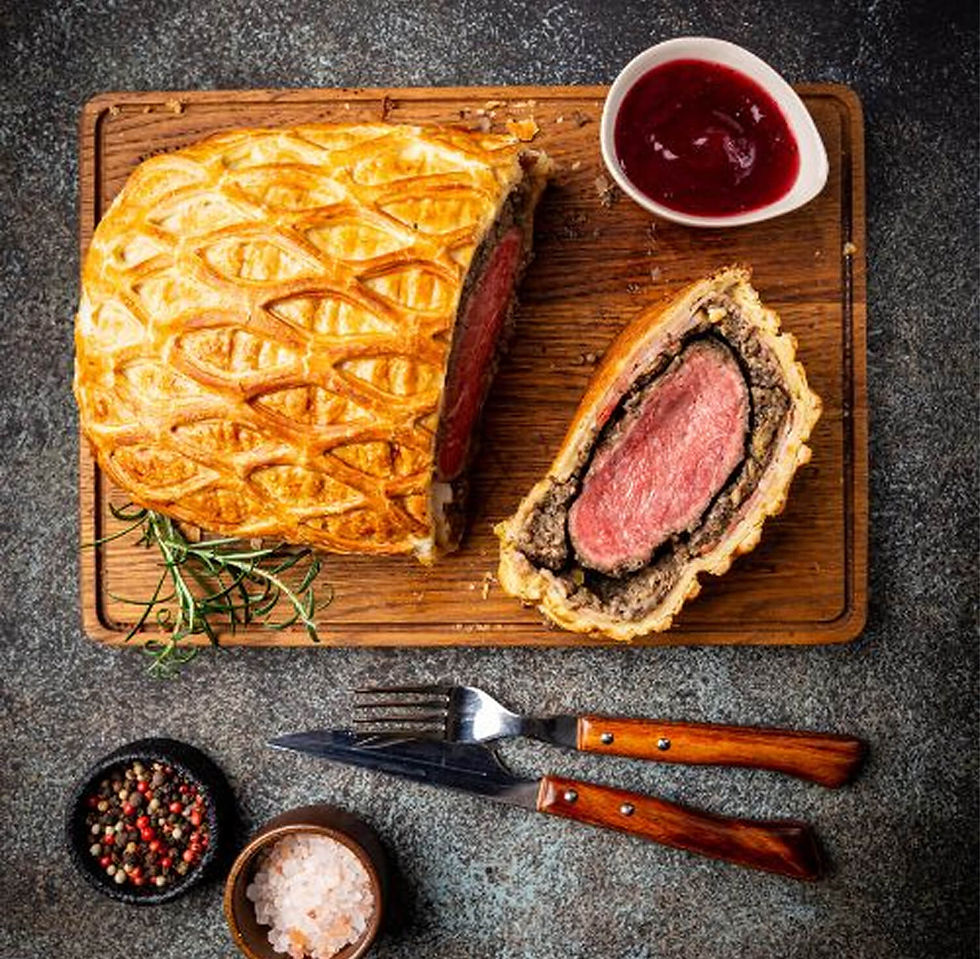<strong>Grilled Blackened Shrimp Po Boys</strong>
- Aug 12, 2022
- 4 min read

My husband loves po boy sandwiches. He orders a po boy any time we eat out and it’s on the menu. Such an odd name for a sandwich. How did it get this name? I did some research and learned its fascinating history.
This po boy originated in New Orleans in 1929 at the Martin Brother’s French Market and Coffee Stand. The brothers, Bennie and Clovis, had both worked as streetcar conductors before opening their market. In 1929 the Electric Street Railway employees went on strike. Sympathetic to their cause, Bennie and Clovis supported the strikers by feeding them sandwiches. The original po boy was made with fried potatoes, gravy, and bits of leftover roast beef and served on French bread. Any time a striker came into the market, one of the brothers would shout, “Here comes another poor boy.” They referred to them as “poor boys” because the strikers were out of work with no income. Eventually the term was shortened to “po boy.” So, that’s how it got its name and how a sandwich was born. The sandwich spread in popularity. Today it’s not just for “po boys”, everyone is eating it, and its filling includes fried shrimp, oysters, and crab. It is so popular you can even find it in convenience stores in New Orleans. The traditional shrimp po boy is dipped in buttermilk and then a flour mixture and fried. We limit the fried foods we eat, so I created a grilled and blackened version. It is delicious and quite filling!
Grilled Blackened Shrimp Po Boys Makes 2 Po Boys
For the blackening spice mix:
2 teaspoons salt 3 teaspoons paprika 1 teaspoon cayenne pepper ¾ teaspoon white pepper ½ teaspoon large grind black pepper ¼ heaping teaspoon ground oregano ¼ heaping teaspoon ground thyme
1 pound large or jumbo shrimp, peeled, deveined, and tails removed Place shrimp in a medium bowl. Add blackening spice mix to taste. (For 2 po boys, I use half the blackening. The above is enough for 2 pounds of shrimp or 4 po boys.) Toss to coat evenly. Let sit while preparing the rémoulade. For the rémoulade:
½ cup mayonnaise 1 teaspoon mustard 1 tablespoon fresh lemon juice ¼ teaspoon Cholula®, or your favorite hot sauce 2 tablespoons sweet pickle relish 1 tablespoon capers 1 teaspoon minced garlic ½ teaspoon blackening spice mix
In a small bowl, place mayonnaise, mustard, lemon juice, hot sauce, pickle relish, capers, garlic, and blackening spice mix. Stir to combine. Cover with plastic wrap and refrigerate until ready to serve.
To cook the shrimp: Cooking spray
Preheat the grill to high. Spray a grill pan with cooking spray. Place shrimp on the grill pan in a single layer and place the pan on the grill. Cook for 2 to 3 minutes. Using a spatula, flip shrimp and cook an additional 2 to 3 minutes, or until shrimp is cooked through. Shrimp should be pink and not opaque, and their tails should curl.
To assemble po boys: 2 French rolls, halved Butter for buttering rolls Shredded iceberg or romaine lettuce Tomato slices, 3 to 4 per sandwich Red onion slices (optional) Blackened shrimp Rémoulade While shrimp is cooking, spread insides of halved rolls with butter and toast lightly on the grill. Once toasted, spread with a spoonful of remoulade. Layer rolls with lettuce, tomato slices, red onion slices, and shrimp. Garnish with rémoulade to taste.
Tips on buying shrimp: Fresh versus Frozen. Fishermen put shrimp on ice as soon as they are caught. This preserves the shrimp, freezing them so they are just-caught fresh until they are thawed. The fresh shrimp you see on ice in the seafood counter at your supermarket were most likely once frozen and are thawing in the counter. The longer they are in the counter, the less fresh they will be. Unless you know that the fresh shrimp you are buying is fresh off the boat, frozen shrimp is a better choice.
Wild-Caught or Farm-Raised: Wild-caught shrimp have a sharper, more shrimpy taste; however, they are pricier and harder to find. Ninety percent of shrimp sold in the United States are imported from Southeast Asia, Ecuador, and India; and the majority of that is farm-raised. Your supermarket is required to divulge the country of origin and whether shrimp is wild or farmed. Check the label. If you have doubts, farm-raised shrimp cultivated under cleaner standards will bear a “Best Aquaculture Practices” label. The certification label to look for when buying wild shrimp is “Marine Stewardship Council Approved.”
The most common imported shrimp sold in the supermarket are white vannemei and tiger shrimp from Asia. The most common domestic varieties are white and pink shrimp from the Gulf of Mexico. If I have a choice, I prefer pink shrimp.
Do not purchase frozen shrimp that have dry spots on their shells. This is a sign of freezer burn. Except for the black tiger variety of shrimp, black spots on shells are an indication of spoilage. Signs of yellow or grit on the shells could mean the shrimp have been bleached to remove black spots. Avoid shrimp that smell like ammonia or feel soft or slimy.
Tips on de-veining shrimp: Unless you are cooking with very small shrimp, they must be de-veined. The intestinal tract on medium to large shrimp runs down their back and is quite unappetizing. To de-vein shrimp, hold them under a slow stream of cold water and run the tip of an ice pick or sharp knife down their back, scraping out the intestine, yet leaving the shrimp intact. Rinse gently to remove any black from the shrimp.
Tips on buying unsoaked shrimp: Shrimp are often soaked in a solution of water and tripolyphosphate. This does extend their shelf life but hurts their flavor. If available, buy the unsoaked or “dry” variety. They have a superior taste. Your supermarket is required by law to tell you whether fish has been soaked in this solution.
Carol Ann
Carol Ann Kates is the award-winning author of cookbook, Secret Recipes from the Corner Market and Insider Grocery Shopping Secrets. She’s an expert in how to shop, select, and store produce for maximizing home cooking outcomes and minimizing time and money spent. As a former supermarket and deli operator, Carol Ann shares grocery-insider wisdom—the same expertise you used to receive when patronizing a mom-and-pop establishment. Contact her at CarolAnn@CarolAnnKates.com and explore her website, www.CarolAnnKates.com.
Copyright 2022 All Rights Reserved Carol Ann Kates
1
Searing the Beef
Sear beef fillets on high heat for 2 minutes per side to form a golden crust. Let it cool before proceeding to keep the beef tender.
1
Searing the Beef
Sear beef fillets on high heat for 2 minutes per side to form a golden crust. Let it cool before proceeding to keep the beef tender.
1
Searing the Beef
Sear beef fillets on high heat for 2 minutes per side to form a golden crust. Let it cool before proceeding to keep the beef tender.
1
Searing the Beef
Sear beef fillets on high heat for 2 minutes per side to form a golden crust. Let it cool before proceeding to keep the beef tender.
Notes



1
Season the good fresh beef fillets with salt and black pepper. Heat olive oil in a pan over high heat and sear the fillets for 2 minutes per side until it fully browned. Remove the beef from the pan and brush with a thin layer of mustard. Let it cool.



1
Season the good fresh beef fillets with salt and black pepper. Heat olive oil in a pan over high heat and sear the fillets for 2 minutes per side until it fully browned. Remove the beef from the pan and brush with a thin layer of mustard. Let it cool.



1
Season the good fresh beef fillets with salt and black pepper. Heat olive oil in a pan over high heat and sear the fillets for 2 minutes per side until it fully browned. Remove the beef from the pan and brush with a thin layer of mustard. Let it cool.



1
Season the good fresh beef fillets with salt and black pepper. Heat olive oil in a pan over high heat and sear the fillets for 2 minutes per side until it fully browned. Remove the beef from the pan and brush with a thin layer of mustard. Let it cool.
Instructions
Quality Fresh 2 beef fillets ( approximately 14 ounces each )
Quality Fresh 2 beef fillets ( approximately 14 ounces each )
Quality Fresh 2 beef fillets ( approximately 14 ounces each )
Beef Wellington

Beef Wellington
Fusion Wizard - Rooftop Eatery in Tokyo
Author Name

Beef Wellington is a luxurious dish featuring tender beef fillet coated with a flavorful mushroom duxelles and wrapped in a golden, flaky puff pastry. Perfect for special occasions, this recipe combines rich flavors and impressive presentation, making it the ultimate centerpiece for any celebration.
Servings :
4 Servings
Calories:
813 calories / Serve
Prep Time
30 mins
Prep Time
30 mins
Prep Time
30 mins
Prep Time
30 mins

Comments